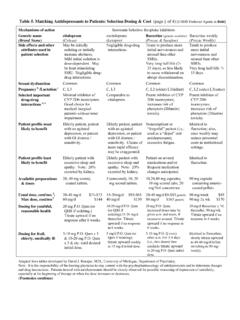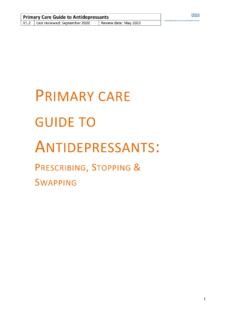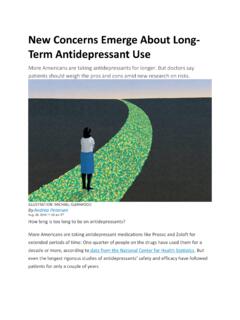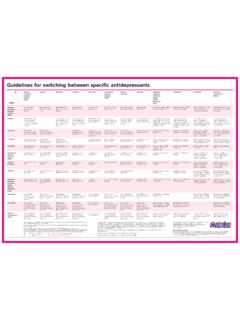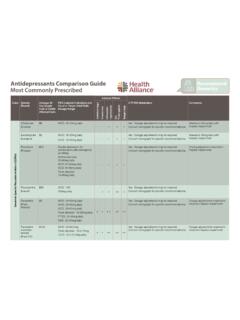Transcription of Antidepressant Medications: Use in Adults
1 Antidepressant Medications: Use in AdultsOctober 2015 The Centers for Medicare & Medicaid Services (CMS) Medicaid Integrity Group (MIG) has identified issues with the utilization of the Antidepressant drug therapy class. The Food and Drug Administration (FDA) approves product labeling for prescription drugs. The MIG has identified that some providers may have prescribed Antidepressant medications outside of FDA-approved product labeling for indication, age, dosage, or duration of therapy. Therefore, CMS goal is to improve quality of care and enhance patient safety by educating providers on the proper use of antidepressants in fact sheet summarizes the current FDA-approved product labeling for the use of Antidepressant medications in adult patients.
2 After reading this fact sheet, providers should be able to accurately: Identify the FDA-approved indications and dosages for the use of Antidepressant medications in Adults ; Identify the available treatment guidelines for use of Antidepressant medications in Adults ; and Summarize the adverse reactions and risks of Antidepressant Indications for Antidepressant Medications in AdultsAccording to a study by the Substance Abuse and Mental Health Services Administration (SAMHSA), the percentage of Adults in the United States had a major depressive episode from 2005 to 2012 has been steady at about percent to 7 percent. In 2012, women were 60 percent more likely to have reported a major depressive episode than men.
3 [1]A survey by the Centers for Disease Control and Prevention (CDC) and the National Center for Health Statistics (NCHS) showed that Antidepressant medications were the prescription medications most frequently used by Adults 20 to 59 years old.[2]Antidepressants are used in Adults to treat depression, major depressive disorder (MDD), obsessive-compulsive disorder (OCD), bulimia nervosa, panic disorder, social anxiety disorder, generalized anxiety disorder (GAD), posttraumatic stress disorder (PTSD), premenstrual dysphoric disorder (PMDD), diabetic peripheral neuropathy, fibromyalgia, chronic musculoskeletal pain, and seasonal affective disorder (SAD).
4 They are also used for smoking cessation, insomnia, moderate to severe vasomotor symptoms associated with menopause, and as adjunct therapies for bipolar I disorder and Parkinson s are several different subclasses of antidepressants: selective serotonin reuptake inhibitors (SSRIs), serotonin-norepinephrine reuptake inhibitors (SNRIs), tricyclic antidepressants (TCAs), and monoamine oxidase inhibitors (MAOIs). Some antidepressants are prescribed exclusively for nonpsychiatric indications, such as insomnia, Parkinson s disease, smoking cessation, and vasomotor symptoms of menopause, but these medications are not covered in this document.
5 There are also other antidepressants that do not fall into any of these drug Medications: Use in Adults2 Refer to the dosing table in the document Antidepressant Medications: Food and Drug Administration-Approved Indications and Dosages for Use in Adults available at on the CMS website for more information. FDA-approved indications vary by medication; therefore, a summary of the indications and the Antidepressant (s) approved to treat each indication is provided in Table 1. FDA-Approved Indications for the Use of Antidepressant Medications in AdultsIndicationMedicationsbipolar I disorderfluoxetine (Prozac )[3]bulimia nervosafluoxetine (Prozac)chronic musculoskeletal painduloxetine[4]depressionamitriptyline ,[5] amoxapine,[6] citalopram,[7] desipramine,[8] doxepin,[9] imipramine,[10] isocarboxazid,[11] maprotiline,[12] nefazodone,[13] nortriptyline,[14] phenelzine,[15] protriptyline,[16] trimipramine[17]diabetic peripheral neuropathyduloxetinefibromyalgiaduloxeti ne, milnacipran[18] GADduloxetine, escitalopram,[19] paroxetine (Paxil [20].)
6 Pexeva [21]), venlafaxine ER[22]MDDbupropion,[23] bupropion SR (Wellbutrin SR),[24] bupropion ER,[25, 26] desvenlafaxine ER,[27, 28] duloxetine, escitalopram, fluoxetine (Prozac), fluoxetine DR,[29] levomilnacipran,[30] mirtazapine,[31] paroxetine (Paxil; Pexeva), paroxetine CR,[32] selegiline,[33] sertraline,[34] tranylcypromine,[35] trazodone,[36] venlafaxine,[37] venlafaxine ER, vilazodone,[38] vortioxetine[39]OCDclomipramine,[40] fluoxetine (Prozac), fluvoxamine,[41] fluvoxamine ER,[42] paroxetine (Paxil; Pexeva), sertralinepanic disorderfluoxetine (Prozac), paroxetine (Paxil; Pexeva), paroxetine CR, sertraline, venlafaxine ERPMDD fluoxetine (Sarafem ),[43] paroxetine CR, sertralinePTSD paroxetine (Paxil), sertralineSADbupropion ERsocial anxiety disorderparoxetine (Paxil), paroxetine CR, sertraline, venlafaxine ERCR = controlled-release DR = delayed-release ER = extended-release SR = sustained-releaseAntidepressant Medications.
7 Use in Adults3 Treatment Guidelines for the Use of Antidepressant Medications in AdultsInformation on some of the treatment guidelines for the use of antidepressants in Adults is available in the National Guideline Clearinghouse database at on the Agency for Healthcare Research and Quality (AHRQ) website. The AHRQ is a branch of the Department of Health and Human Services. Links to some of the treatment guidelines for the use of antidepressants in Adults are provided in Table 2. Treatment Guidelines for the Use of Antidepressant Medications in AdultsSponsoring OrganizationTitle of GuidelineLink to GuidelineAmerican Psychiatric AssociationPractice guideline for the treatment of patients with obsessive-compulsive disorder.
8 [2012] Psychiatric AssociationPractice guideline for the treatment of patients with major depressive disorder, third edition. [2010] of Veterans Affairs (VA), Department of Defense (DoD): Management of Post-Traumatic Stress Working GroupVA/DoD clinical practice guideline for management of post-traumatic stress. [2010] for Clinical Systems ImprovementAdult depression in primary care. [2013] Reactions and Risks of Antidepressant MedicationsAdverse reactions vary for each Antidepressant drug subclass. SSRIs and SNRIs are the most frequently used antidepressants because they tend to have less bothersome adverse reactions than most of the other antidepressants.
9 The most common adverse reactions of SSRIs and SNRIs are headache, nausea, sedation, agitation, and sexual problems. Hyponatremia has been reported with SSRIs and SNRIs, which may be secondary to drug-induced syndrome of inappropriate antidiuretic hormone secretion (SIADH). Symptoms of SIADH are confusion, weakness, difficulty concentrating, and memory impairment. Patients who develop hyponatremia should have appropriate medical intervention, and discontinuation of the SSRI or SNRI should be considered.[44]TCAs have anticholinergic properties that cause many troublesome adverse reactions, such as dry mouth, constipation, urinary retention, and blurred vision.
10 Drowsiness is the most common side effect and usually subsides as therapy continues. TCAs should be used with caution in patients with a heart condition. A TCA overdose may be lethal.[45]The use of MAOIs is limited because they have several contraindications which include: Presence of a cerebrovascular defect; Presence of a cardiovascular disorder; Presence of a pheochromocytoma; Consumption of tyramine-containing foods; and Potential for serious drug interactions with some medications.[46] Antidepressant Medications: Use in Adults4 MAOIs also have a warning that they may cause a potentially fatal hypertensive crisis when tyramine-containing foods are consumed.










